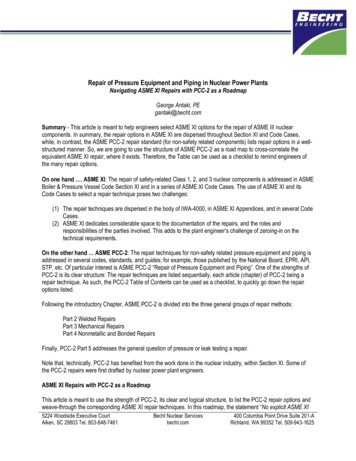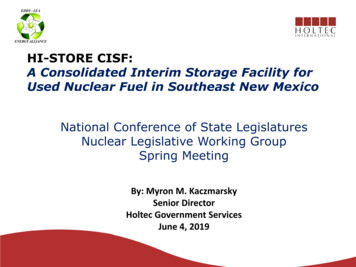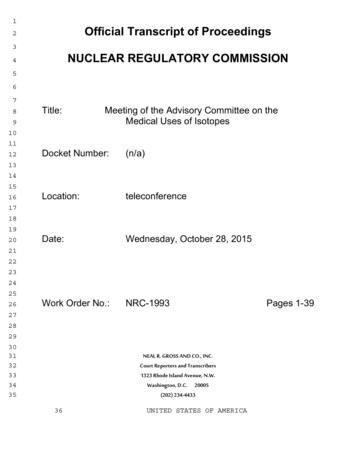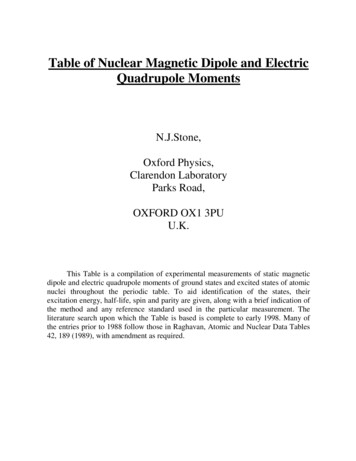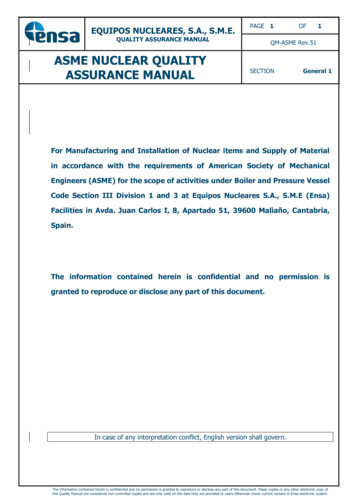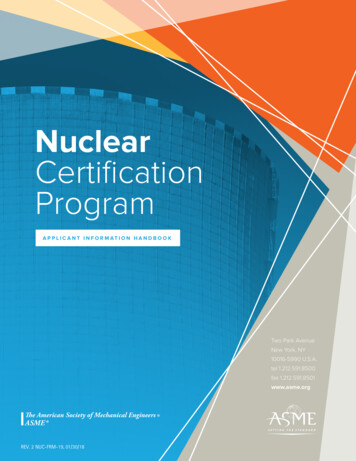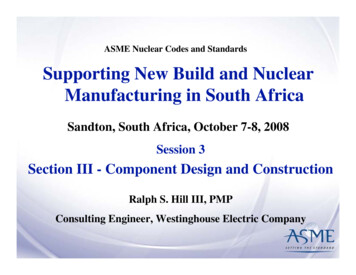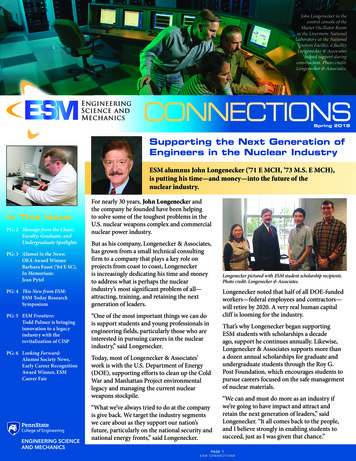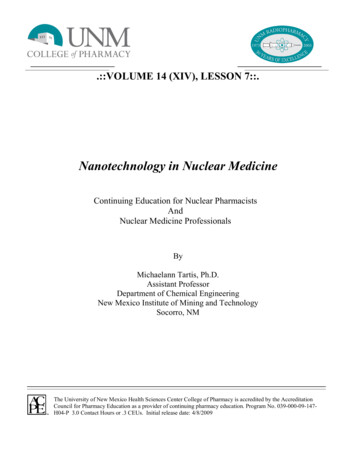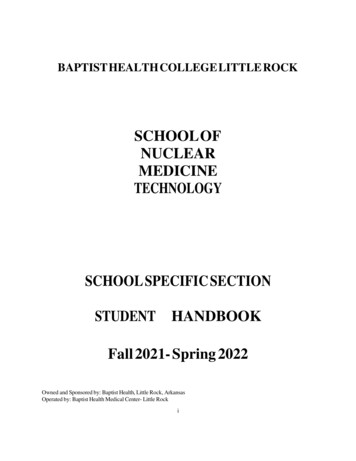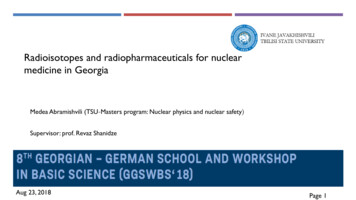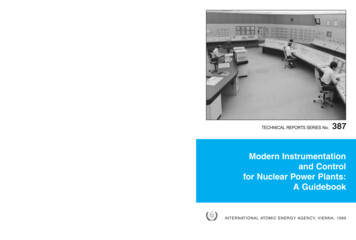
Transcription
Modern Instrumentation and Controlfor Nuclear Power Plants:A GuidebookTECHNICAL REPORTS SERIES No.Technical Reports Series No. 387ISBN 92–0–101199–7ISSN 0074–1914387Modern Instrumentationand Controlfor Nuclear Power Plants:A GuidebookINTERNATIONAL ATOMIC ENERGY AGENCY, VIENNA, 1999
MODERN INSTRUMENTATIONAND CONTROLFOR NUCLEAR POWER PLANTSA Guidebook
The following States are Members of the International Atomic Energy A ANDHERZEGOVINABRAZILBULGARIABURKINA FASOCAMBODIACAMEROONCANADACHILECHINACOLOMBIACOSTA RICACOTE D’IVOIRECROATIACUBACYPRUSCZECH REPUBLICDEMOCRATIC REPUBLICOF THE CONGODENMARKDOMINICAN REPUBLICECUADOREGYPTEL RMANYGHANAGREECEGUATEMALAHAITIHOLY SEEHUNGARYICELANDINDIAINDONESIAIRAN, ISLAMIC REPUBLIC ANKENYAKOREA, REPUBLIC OFKUWAITLATVIALEBANONLIBERIALIBYAN ARAB ARMALAYSIAMALIMALTAMARSHALL NAMIBIANETHERLANDSNEW RAGUAYPERUPHILIPPINESPOLANDPORTUGALQATARREPUBLIC OF MOLDOVAROMANIARUSSIAN FEDERATIONSAUDI ARABIASENEGALSIERRA LEONESINGAPORESLOVAKIASLOVENIASOUTH AFRICASPAINSRI LANKASUDANSWEDENSWITZERLANDSYRIAN ARAB REPUBLICTHAILANDTHE FORMER YUGOSLAVREPUBLIC OF MACEDONIATUNISIATURKEYUGANDAUKRAINEUNITED ARAB EMIRATESUNITED KINGDOM OFGREAT BRITAIN ANDNORTHERN IRELANDUNITED REPUBLICOF TANZANIAUNITED STATESOF AMERICAURUGUAYUZBEKISTANVENEZUELAVIET NAMYEMENYUGOSLAVIAZAMBIAZIMBABWEThe Agency’s Statute was approved on 23 October 1956 by the Conference on the Statute of theIAEA held at United Nations Headquarters, New York; it entered into force on 29 July 1957. TheHeadquarters of the Agency are situated in Vienna. Its principal objective is “to accelerate and enlarge thecontribution of atomic energy to peace, health and prosperity throughout the world’’. IAEA, 1999Permission to reproduce or translate the information contained in this publication may beobtained by writing to the International Atomic Energy Agency, Wagramer Strasse 5, P.O. Box 100,A-1400 Vienna, Austria.Printed by the IAEA in AustriaJune 1999STI/DOC/010/387
TECHNICAL REPORTS SERIES No. 387MODERN INSTRUMENTATIONAND CONTROLFOR NUCLEAR POWER PLANTSA GuidebookINTERNATIONAL ATOMIC ENERGY AGENCYVIENNA, 1999
VIC Library Cataloguing in Publication DataModern instrumentation and control for nuclear power plants : a guidebook. —Vienna : International Atomic Energy Agency, 1999.p. ; 24 cm. — (Technical reports series, ISSN 0074–1914 ; no. 387)STI/DOC/010/387ISBN 92–0–101199–7Includes bibliographical references.1. Nuclear power plants—Instrumentation. 2. Nuclear power plants—Control. I. International Atomic Energy Agency. II. Series: Technicalreports series (International Atomic Energy Agency); 387.VICL99–00224
FOREWORDThe IAEA has produced many publications which aim to promote safety andprovide guidance in the planning, introduction and use of nuclear power. The IAEAInternational Working Group on Nuclear Power Plant Control and Instrumentationrecommended that a guidebook be written as part of this work, to summarize the fieldof nuclear power plant instrumentation and control and, particularly, to advise thosepreparing their first nuclear power project. This led, in 1984, to the publication ofNuclear Power Plant Instrumentation and Control: A Guidebook (Technical ReportsSeries No. 239).The guidebook was well received and has been widely used by a variety oforganizations and professionals, over a thousand copies having been distributed.More recently, however, it became clear that an update was desirable and in 1993 aconsultants meeting was convened to advise on a version which would meet therequirements of today’s world and still be valid in the beginning of the next century.The consultants concluded that major revision was necessary but that the emphasisought to be changed from guidance to summarizing operating experience anddiscussing new technologies.Whereas the previous edition was aimed at readers who were new toinstrumentation and control technology, this is no longer considered appropriate andthe present version is primarily directed at those who are working as instrumentationand control engineers on operational plant. However, it does not exclude designersand regulators, who should also find the content useful. Although this editioncontinues to discuss PWRs, BWRs and CANDU reactors, modern convergence oftechnology is recognized by the inclusion of detailed information on RBMK andWWER reactor types.To avoid generalities and a flavour of blandness, numbers and preferred orrecommended methods are often mentioned. It is recognized, however, that mostcountries have their own unique national infrastructures and have, accordingly,evolved individual solutions to common problems. Thus, numbers and recommendations are not necessarily universal and only represent solutions for a given set ofcircumstances. Nevertheless, it is hoped that the reader will find food for thought,assistance in problem identification and guidelines for solutions. In summary, thisguidebook provides an overview of nuclear power plant instrumentation and controltechnology and the background against which such systems are implemented.The material which is presented was selected and assembled by an internationalgroup of consultants listed at the end of the book. Gratitude is expressed to all of thecontributors for their collaboration. The final text was prepared by A. Goodings(United Kingdom) and the IAEA officers responsible for the project were A. Kossilovand V. Neboyan of the Division of Nuclear Power.
EDITORIAL NOTEAlthough great care has been taken to maintain the accuracy of information containedin this publication, neither the IAEA nor its Member States assume any responsibility forconsequences which may arise from its use.The use of particular designations of countries or territories does not imply anyjudgement by the publisher, the IAEA, as to the legal status of such countries or territories, oftheir authorities and institutions or of the delimitation of their boundaries.The mention of names of specific companies or products (whether or not indicated asregistered) does not imply any intention to infringe proprietary rights, nor should it beconstrued as an endorsement or recommendation on the part of the IAEA.
CONTENTS1.GENERAL INTRODUCTION . . . . . . . . . . . . . . . . . . . . . . . . . . . . . . . .11.1.1.2.1.3.123PART I.Importance of instrumentation and control . . . . . . . . . . . . . . . . .Background to new edition . . . . . . . . . . . . . . . . . . . . . . . . . . . . .Scope of new edition . . . . . . . . . . . . . . . . . . . . . . . . . . . . . . . . .REQUIREMENTS, CONSTRAINTS AND RECENT ISSUES2.INTRODUCTION TO PART I . . . . . . . . . . . . . . . . . . . . . . . . . . . . . . . .93.OPERATIONAL FACTORS . . . . . . . . . . . . . . . . . . . . . . . . . . . . . . . . . .113.1.3.2.3.3.3.4.3.5.Load following requirements . . . . . . . . . . . . . . . . . . . . . . . . . . .Constraints with respect to reactor type . . . . . . . . . . . . . . . . . . .Recent issues with respect to margins and robustness . . . . . . . . .Combined heat and power production . . . . . . . . . . . . . . . . . . . . .Maintainability . . . . . . . . . . . . . . . . . . . . . . . . . . . . . . . . . . . . . .1112131314IMPACT OF OPERATING EXPERIENCE . . . . . . . . . . . . . . . . . . . . . .154.1.4.2.General . . . . . . . . . . . . . . . . . . . . . . . . . . . . . . . . . . . . . . . . . . . .Experience from normal operation . . . . . . . . . . . . . . . . . . . . . . .4.2.1.Plant availability . . . . . . . . . . . . . . . . . . . . . . . . . . . . .4.2.2.Operator support . . . . . . . . . . . . . . . . . . . . . . . . . . . . .4.2.3.Testing and calibration . . . . . . . . . . . . . . . . . . . . . . . .4.2.4.Human error . . . . . . . . . . . . . . . . . . . . . . . . . . . . . . . .4.2.5.New technology . . . . . . . . . . . . . . . . . . . . . . . . . . . . .Experience from incidents and accidents . . . . . . . . . . . . . . . . . . .4.3.1.Anticipated transient without scram . . . . . . . . . . . . . . .4.3.2.Three Mile Island . . . . . . . . . . . . . . . . . . . . . . . . . . . .4.3.3.Chernobyl . . . . . . . . . . . . . . . . . . . . . . . . . . . . . . . . . .Maintenance experience . . . . . . . . . . . . . . . . . . . . . . . . . . . . . . .151616171718181919192121SAFETY AND REGULATORY FACTORS . . . . . . . . . . . . . . . . . . . . . .245.1.5.2.2424254.4.3.4.4.5.Background . . . . . . . . . . . . . . . . . . . . . . . . . . . . . . . . . . . . . . . .Defence in depth . . . . . . . . . . . . . . . . . . . . . . . . . . . . . . . . . . . . .5.2.1.Design requirements . . . . . . . . . . . . . . . . . . . . . . . . . .
5.3.5.4.5.5.5.6.5.7.5.8.6.Introduction . . . . . . . . . . . . . . . . . . . . . . . . . . . . . . . . . . . . . . . .National safety guides and standards . . . . . . . . . . . . . . . . . . . . .International safety guides and standards . . . . . . . . . . . . . . . . . .7.3.1.IAEA Codes and Safety Guides . . . . . . . . . . . . . . . . . .7.3.2.IEC standards, guides and reports . . . . . . . . . . . . . . . .7.3.3.Other international standards . . . . . . . . . . . . . . . . . . . .323333333434TECHNOLOGICAL EVOLUTION . . . . . . . . . . . . . . . . . . . . . . . . . . . . 378.1.8.2.8.3.8.4.8.5.8.6.8.7.8.8.9.General . . . . . . . . . . . . . . . . . . . . . . . . . . . . . . . . . . . . . . . . . . . . 29Main control room . . . . . . . . . . . . . . . . . . . . . . . . . . . . . . . . . . . 29Post-accident management . . . . . . . . . . . . . . . . . . . . . . . . . . . . . 31SAFETY GUIDES AND STANDARDS . . . . . . . . . . . . . . . . . . . . . . . . 327.1.7.2.7.3.8.2525262626272727MANAGEMENT OF ACCIDENT AND POST-ACCIDENTCONDITIONS . . . . . . . . . . . . . . . . . . . . . . . . . . . . . . . . . . . . . . . . . . . . 296.1.6.2.6.3.7.5.2.2.Failure modes and effects analysis . . . . . . . . . . . . . . . .5.2.3.Probabilistic safety assessment . . . . . . . . . . . . . . . . . .Categorization of I&C functions important to safety . . . . . . . . . .Emergency response centres . . . . . . . . . . . . . . . . . . . . . . . . . . . .Severe accident response . . . . . . . . . . . . . . . . . . . . . . . . . . . . . .Software reliability . . . . . . . . . . . . . . . . . . . . . . . . . . . . . . . . . . .Personnel radiation exposure . . . . . . . . . . . . . . . . . . . . . . . . . . .Proof of performance . . . . . . . . . . . . . . . . . . . . . . . . . . . . . . . . .Introduction . . . . . . . . . . . . . . . . . . . . . . . . . . . . . . . . . . . . . . . .Digital electronics . . . . . . . . . . . . . . . . . . . . . . . . . . . . . . . . . . . .Microprocessor based systems . . . . . . . . . . . . . . . . . . . . . . . . . .8.3.1.Computer based monitoring and control systems . . . . .8.3.2.Personal computers . . . . . . . . . . . . . . . . . . . . . . . . . . .Computer system peripherals . . . . . . . . . . . . . . . . . . . . . . . . . . .Software engineering . . . . . . . . . . . . . . . . . . . . . . . . . . . . . . . . .Information displays . . . . . . . . . . . . . . . . . . . . . . . . . . . . . . . . . .Communications . . . . . . . . . . . . . . . . . . . . . . . . . . . . . . . . . . . . .Expert systems . . . . . . . . . . . . . . . . . . . . . . . . . . . . . . . . . . . . . .37373738383838393940MODERNIZATION AND LIFE EXTENSION FACTORS . . . . . . . . . . 409.1.Introduction . . . . . . . . . . . . . . . . . . . . . . . . . . . . . . . . . . . . . . . . 40
9.2.9.3.Changes due to plant factors . . . . . . . . . . . . . . . . . . . . . . . . . . . .9.2.1.Requirements . . . . . . . . . . . . . . . . . . . . . . . . . . . . . . .9.2.2.Constraints . . . . . . . . . . . . . . . . . . . . . . . . . . . . . . . . .9.2.3.Recent issues . . . . . . . . . . . . . . . . . . . . . . . . . . . . . . . .Changes due to I&C factors . . . . . . . . . . . . . . . . . . . . . . . . . . . .9.3.1.Requirements . . . . . . . . . . . . . . . . . . . . . . . . . . . . . . .9.3.2.Constraints . . . . . . . . . . . . . . . . . . . . . . . . . . . . . . . . .9.3.3.Recent issues . . . . . . . . . . . . . . . . . . . . . . . . . . . . . . . .414141414242424310.HUMAN PERFORMANCE REQUIREMENTS . . . . . . . . . . . . . . . . . . 4411.TEAMS AND TRAINING . . . . . . . . . . . . . . . . . . . . . . . . . . . . . . . . . . . 4511.1.11.2.11.3.11.4.12.Team structures . . . . . . . . . . . . . . . . . . . . . . . . . . . . . . . . . . . . .Team training . . . . . . . . . . . . . . . . . . . . . . . . . . . . . . . . . . . . . . .Role of simulator training . . . . . . . . . . . . . . . . . . . . . . . . . . . . . .Methods of simulator training . . . . . . . . . . . . . . . . . . . . . . . . . . .11.4.1. Job task analysis . . . . . . . . . . . . . . . . . . . . . . . . . . . . .11.4.2. Tasks for which training is required . . . . . . . . . . . . . . .11.4.3. Training objectives . . . . . . . . . . . . . . . . . . . . . . . . . . .11.4.4. Types of simulator and their recommended uses . . . . .4548495050515151QUALITY ASSURANCE AND STANDARDIZATIONOF PLANTS . . . . . . . . . . . . . . . . . . . . . . . . . . . . . . . . . . . . . . . . . . . . . 5312.1.12.2.12.3.12.4.12.5.Background . . . . . . . . . . . . . . . . . . . . . . . . . . . . . . . . . . . . . . . .12.1.1. Historical situation . . . . . . . . . . . . . . . . . . . . . . . . . . .12.1.2. Future situation . . . . . . . . . . . . . . . . . . . . . . . . . . . . . .12.1.3. Present situation . . . . . . . . . . . . . . . . . . . . . . . . . . . . .Requirements . . . . . . . . . . . . . . . . . . . . . . . . . . . . . . . . . . . . . . .12.2.1. Hard-wired systems . . . . . . . . . . . . . . . . . . . . . . . . . . .12.2.2. Software based systems . . . . . . . . . . . . . . . . . . . . . . . .Quality assurance planning and quality control . . . . . . . . . . . . . .Tests, checks and procedures . . . . . . . . . . . . . . . . . . . . . . . . . . .12.4.1. Type tests . . . . . . . . . . . . . . . . . . . . . . . . . . . . . . . . . .12.4.2. Factory tests . . . . . . . . . . . . . . . . . . . . . . . . . . . . . . . .12.4.3. Functional tests . . . . . . . . . . . . . . . . . . . . . . . . . . . . . .12.4.4. Tests during operation . . . . . . . . . . . . . . . . . . . . . . . . .Standardization of plants and their I&C equipment . . . . . . . . . . .12.5.1. Plants and systems . . . . . . . . . . . . . . . . . . . . . . . . . . . .12.5.2. I&C equipment . . . . . . . . . . . . . . . . . . . . . . . . . . . . . .53535454545455555656575757575758
PART II. DESIGN CONCEPTS13.GENERAL ASPECTS . . . . . . . . . . . . . . . . . . . . . . . . . . . . . . . . . . . . . . 6313.1.13.2.13.3.14.Introduction . . . . . . . . . . . . . . . . . . . . . . . . . . . . . . . . . . . . . . . .Levels of protection . . . . . . . . . . . . . . . . . . . . . . . . . . . . . . . . . .Categorization of I&C functions . . . . . . . . . . . . . . . . . . . . . . . . .Redundancy, diversity, separation and failure to safety . . . . . . . .14.4.1. Redundancy . . . . . . . . . . . . . . . . . . . . . . . . . . . . . . . .14.4.2. Diversity . . . . . . . . . . . . . . . . . . . . . . . . . . . . . . . . . . .14.4.3. Separation . . . . . . . . . . . . . . . . . . . . . . . . . . . . . . . . . .14.4.4. Failure to safety . . . . . . . . . . . . . . . . . . . . . . . . . . . . . .6969717171727373INSTRUMENTATION AND CONTROL STRUCTURES . . . . . . . . . . . 7415.1.15.2.15.3.16.63656666666768DEFENCE IN DEPTH . . . . . . . . . . . . . . . . . . . . . . . . . . . . . . . . . . . . . . 6914.1.14.2.14.3.14.4.15.Basic philosophy . . . . . . . . . . . . . . . . . . . . . . . . . . . . . . . . . . . .Design factors . . . . . . . . . . . . . . . . . . . . . . . . . . . . . . . . . . . . . . .Methods of implementation . . . . . . . . . . . . . . . . . . . . . . . . . . . .13.3.1. General principles . . . . . . . . . . . . . . . . . . . . . . . . . . . .13.3.2. Failure to safety and defence in depth . . . . . . . . . . . . .13.3.3. Quality assurance in design and supply process . . . . . .13.3.4. Codes of practice and terminology . . . . . . . . . . . . . . .General . . . . . . . . . . . . . . . . . . . . . . . . . . . . . . . . . . . . . . . . . . . .Main structures . . . . . . . . . . . . . . . . . . . . . . . . . . . . . . . . . . . . . .Structures of subsidiary units . . . . . . . . . . . . . . . . . . . . . . . . . . .15.3.1. Analog systems . . . . . . . . . . . . . . . . . . . . . . . . . . . . . .15.3.2. Digital systems . . . . . . . . . . . . . . . . . . . . . . . . . . . . . .7475767677BALANCE BETWEEN AUTOMATION ANDHUMAN ACTION . . . . . . . . . . . . . . . . . . . . . . . . . . . . . . . . . . . . . . . . . 7816.1.16.2.Background . . . . . . . . . . . . . . . . . . . . . . . . . . . . . . . . . . . . . . . .16.1.1. Historical situation . . . . . . . . . . . . . . . . . . . . . . . . . . .16.1.2. Future situation . . . . . . . . . . . . . . . . . . . . . . . . . . . . . .16.1.3. Present situation . . . . . . . . . . . . . . . . . . . . . . . . . . . . .Disadvantages and advantages of human action . . . . . . . . . . . . .16.2.1. Disadvantages . . . . . . . . . . . . . . . . . . . . . . . . . . . . . . .16.2.2. Advantages . . . . . . . . . . . . . . . . . . . . . . . . . . . . . . . . .78787979797980
16.3.16.4.17.18.3.868789899090Historical situation . . . . . . . . . . . . . . . . . . . . . . . . . . . . . . . . . . .Present situation . . . . . . . . . . . . . . . . . . . . . . . . . . . . . . . . . . . . .18.2.1. Maintenance support . . . . . . . . . . . . . . . . . . . . . . . . . .18.2.2. Engineering support . . . . . . . . . . . . . . . . . . . . . . . . . .18.2.3. Environmental supervision . . . . . . . . . . . . . . . . . . . . .18.2.4. Core management . . . . . . . . . . . . . . . . . . . . . . . . . . . .Typical design . . . . . . . . . . . . . . . . . . . . . . . . . . . . . . . . . . . . . .92939393939495ACCIDENT MONITORING INSTRUMENTATION . . . . . . . . . . . . . . . 9719.1.19.2.19.3.19.4.20.Introduction . . . . . . . . . . . . . . . . . . . . . . . . . . . . . . . . . . . . . . . .Presentation of information . . . . . . . . . . . . . . . . . . . . . . . . . . . . .Control aspects . . . . . . . . . . . . . . . . . . . . . . . . . . . . . . . . . . . . . .Layout of controls and panels . . . . . . . . . . . . . . . . . . . . . . . . . . .Integration of procedures and operations . . . . . . . . . . . . . . . . . . .Full-scope simulators . . . . . . . . . . . . . . . . . . . . . . . . . . . . . . . . .COMPUTERS FOR PLANT MANAGEMENT . . . . . . . . . . . . . . . . . . . 9218.1.18.2.19.8080818182838384HUMAN FACTORS ENGINEERING . . . . . . . . . . . . . . . . . . . . . . . . . . 8617.1.17.2.17.3.17.4.17.5.17.6.18.Disadvantages and advantages of automatic action . . . . . . . . . . .16.3.1. Introduction . . . . . . . . . . . . . . . . . . . . . . . . . . . . . . . . .16.3.2. Disadvantages . . . . . . . . . . . . . . . . . . . . . . . . . . . . . . .16.3.3. Advantages . . . . . . . . . . . . . . . . . . . . . . . . . . . . . . . . .Balance and assignment of functions . . . . . . . . . . . . . . . . . . . . .16.4.1. First, rough assignment of tasks and functions . . . . . . .16.4.2. First refinement of design and assessment . . . . . . . . . .16.4.3. Final balancing of tasks and functions . . . . . . . . . . . . .Design criteria . . . . . . . . . . . . . . . . . . . . . . . . . . . . . . . . . . . . . .Variable types . . . . . . . . . . . . . . . . . . . . . . . . . . . . . . . . . . . . . . .Selection criteria for variables . . . . . . . . . . . . . . . . . . . . . . . . . . .Severe accidents . . . . . . . . . . . . . . . . . . . . . . . . . . . . . . . . . . . . .979798100POWER SUPPLIES . . . . . . . . . . . . . . . . . . . . . . . . . . . . . . . . . . . . . . . . 10120.1.20.2.Electrical power supplies . . . . . . . . . . . . . . . . . . . . . . . . . . . . . .20.1.1. Principles . . . . . . . . . . . . . . . . . . . . . . . . . . . . . . . . . .20.1.2. System design . . . . . . . . . . . . . . . . . . . . . . . . . . . . . . .Non-electrical power supplies and ventilation systems . . . . . . . .101101102105
21.ENVIRONMENTAL INFLUENCES . . . . . . . . . . . . . . . . . . . . . . . . . . . 10621.1.21.2.21.3.21.4.21.5.21.6.21.7.22.Accident conditions . . . . . . . . . . . . . . . . . . . . . . . . . . . . . . . . . .Fire . . . . . . . . . . . . . . . . . . . . . . . . . . . . . . . . . . . . . . . . . . . . . . .Seismic effects . . . . . . . . . . . . . . . . . . . . . . . . . . . . . . . . . . . . . .Air-conditioning . . . . . . . . . . . . . . . . . . . . . . . . . . . . . . . . . . . . .Electromagnetic interference . . . . . . . . . . . . . . . . . . . . . . . . . . . .Other external hazards . . . . . . . . . . . . . . . . . . . . . . . . . . . . . . . .Physical security . . . . . . . . . . . . . . . . . . . . . . . . . . . . . . . . . . . . .QUALIFICATION . . . . . . . . . . . . . . . . . . . . . . . . . . . . . . . . . . . . . . . . . 11222.1. Requirements . . . . . . . . . . . . . . . . . . . . . . . . . . . . . . . . . . . . . . .22.1.1. Specifications . . . . . . . . . . . . . . . . . . . . . . . . . . . . . . .22.1.2. Documentation . . . . . . . . . . . . . . . . . . . . . . . . . . . . . .22.2. Methods of qualification . . . . . . . . . . . . . . . . . . . . . . . . . . . . . . .22.3. Particular factors applying to software . . . . . . . . . . . . . . . . . . . .22.4. Maintenance of qualification . . . . . . . . . . . . . . . . . . . . . . . . . . . NABILITY AND MAINTENANCE . . . . . . . . . . . . . . . . . . . 11723.1. Requirements . . . . . . . . . . . . . . . . . . . . . . . . . . . . . . . . . . . . . . .23.2. Influence of organizational, industrial andtechnological environments . . . . . . . . . . . . . . . . . . . . . . . . . . . . .23.3. Design for maintenance . . . . . . . . . . . . . . . . . . . . . . . . . . . . . . .23.3.1. System design . . . . . . . . . . . . . . . . . . . . . . . . . . . . . . .23.3.2. Equipment design . . . . . . . . . . . . . . . . . . . . . . . . . . . .23.4. Organization of maintenance . . . . . . . . . . . . . . . . . . . . . . . . . . .23.5. Maintenance activities . . . . . . . . . . . . . . . . . . . . . . . . . . . . . . . .23.5.1. Training . . . . . . . . . . . . . . . . . . . . . . . . . . . . . . . . . . .23.5.2. Front line maintenance and support . . . . . . . . . . . . . . .23.5.3. Diagnosis and repair . . . . . . . . . . . . . . . . . . . . . . . . . .23.5.4. Preventive maintenance activities . . . . . . . . . . . . . . . .23.5.5. Shop calibration, repair, maintenance and salvage . . . .23.5.6. Documentation . . . . . . . . . . . . . . . . . . . . . . . . . . . . . .23.5.7. Maintenance of equipment historiesand evaluations . . . . . . . . . . . . . . . . . . . . . . . . . . . . . .23.5.8. Materials management . . . . . . . . . . . . . . . . . . . . . . . . .23.6. Plant performance analysis and modifications . . . . . . . . . . . . . . .117118119119120120121121122122123124124125125126
PART III.24.RECENT DEVELOPMENTS IN INSTRUMENTATIONAND CONTROLMAIN CONTROL ROOM . . . . . . . . . . . . . . . . . . . . . . . . . . . . . . . . . . . 12924.1. Introduction . . . . . . . . . . . . . . . . . . . . . . . . . . . . . . . . . . . . . . . .24.2. Recent trends . . . . . . . . . . . . . . . . . . . . . . . . . . . . . . . . . . . . . . .24.2.1. Increase in complexity and information . . . . . . . . . . . .24.2.2. Computers in monitoring and control . . . . . . . . . . . . .24.2.3. Control desk . . . . . . . . . . . . . . . . . . . . . . . . . . . . . . . .24.2.4. Dark panel concept . . . . . . . . . . . . . . . . . . . . . . . . . . .24.2.5. Standards and regulatory requirements . . . . . . . . . . . .24.2.6. Control room backfits . . . . . . . . . . . . . . . . . . . . . . . . .24.3. Human factors . . . . . . . . . . . . . . . . . . . . . . . . . . . . . . . . . . . . . .24.4. Human–machine interface . . . . . . . . . . . . . . . . . . . . . . . . . . . . .24.4.1. Increased use of computer driven displays . . . . . . . . . .24.4.2. Task and symptom oriented information . . . . . . . . . . .24.4.3. Console operation . . . . . . . . . . . . . . . . . . . . . . . . . . . .24.4.4. Advanced graphical user interface . . . . . . . . . . . . . . . .24.5. Information display . . . . . . . . . . . . . . . . . . . . . . . . . . . . . . . . . .24.5.1. Computer driven information systems . . . . . . . . . . . . .24.5.2. Large mimic displays . . . . . . . . . . . . . . . . . . . . . . . . .24.5.3. VDU display design . . . . . . . . . . . . . . . . . . . . . . . . . .24.6. Alarm processing and annunciation and command interfaces . . .24.6.1. Alarm flooding . . . . . . . . . . . . . . . . . . . . . . . . . . . . . .24.6.2. Alarm windows . . . . . . . . . . . . . . . . . . . . . . . . . . . . . .24.6.3. Auditory devices . . . . . . . . . . . . . . . . . . . . . . . . . . . . .24.7. Video monitoring . . . . . . . . . . . . . . . . . . . . . . . . . . . . . . . . . . . 34135136136136137137138OPERATOR SUPPORT . . . . . . . . . . . . . . . . . . . . . . . . . . . . . . . . . . . . . 14025.1. Introduction . . . . . . . . . . . . . . . . . . . . . . . . . . . . . . . . . . . . . . . .25.2. Types of operator support system . . . . . . . . . . . . . . . . . . . . . . . .25.3. Handling of procedures . . . . . . . . . . . . . . . . . . . . . . . . . . . . . . . .25.3.1. Computerized procedures . . . . . . . . . . . . . . . . . . . . . .25.3.2. Procedure selection . . . . . . . . . . . . . . . . . . . . . . . . . . .25.4. On-line diagnosis . . . . . . . . . . . . . . . . . . . . . . . . . . . . . . . . . . . .25.4.1. Safety parameter display systems . . . . . . . . . . . . . . . .25.4.2. Critical safety parameter monitor . . . . . . . . . . . . . . . . .25.4.3. Emergency operating procedure entrycondition monitor . . . . . . . . . . . . . . . . . . . . . . . . . . . .140140142142142143143144144
25.5.25.6.25.7.25.8.25.9.26.General . . . . . . . . . . . . . . . . . . . . . . . . . . . . . . . . . . . . . . . . . . . .Changes in last decade . . . . . . . . . . . . . . . . . . . . . . . . . . . . . . . .Increased use of automation . . . . . . . . . . . . . . . . . . . . . . . . . . . .Computer applications . . . . . . . . . . . . . . . . . . . . . . . . . . . . . . . .Issues in computer usage . . . . . . . . . . . . . . . . . . . . . . . . . . . . . .149150155155156LIMITATION SYSTEMS . . . . . . . . . . . . . . . . . . . . . . . . . . . . . . . . . . . ROL SYSTEMS . . . . . . . . . . . . . . . . . . . . . . . . . . . . . . . . . . . . . 14926.1.26.2.26.3.26.4.26.5.27.Core surveillance systems . . . . . . . . . . . . . . . . . . . . . . . . . . . . . .Plant state prediction . . . . . . . . . . . . . . . . . . . . . . . . . . . . . . . . .Post-accident analysis . . . . . . . . . . . . . . . . . . . . . . . . . . . . . . . . .Reference engineering databases . . . . . . . . . . . . . . . . . . . . . . . . .Future systems . . . . . . . . . . . . . . . . . . . . . . . . . . . . . . . . . . . . . .Historical development . . . . . . . . . . . . . . . . . . . . . . . . . . . . . . . .Working regions . . . . . . . . . . . . . . . . . . . . . . . . . . . . . . . . . . . . .27.2.1. Safety systems . . . . . . . . . . . . . . . . . . . . . . . . . . . . . . .27.2.2. Safety related systems . . . . . . . . . . . . . . . . . . . . . . . . .27.2.3. Control systems . . . . . . . . . . . . . . . . . . . . . . . . . . . . . .27.2.4. Limitation systems . . . . . . . . . . . . . . . . . . . . . . . . . . .Characteristics of protection, control and limitation systems . . . .Advantages of limitation systems . . . . . . . . . . . . . . . . . . . . . . . .27.4.1. Advantages for operators . . . . . . . . . . . . . . . . . . . . . . .27.4.2. Advantages for licensing procedure . . . . . . . . . . . . . . .27.4.3. Advantages for availability . . . . . . . . . . . . . . . . . . . . .27.4.4. Advantages for reliability . . . . . . . . . . . . . . . . . . . . . .27.4.5. Overall aspects . . . . . . . . . . . . . . . . . . . . . . . . . . . . . .Possible future developments . . . . . . . . . . . . . . . . . . . . . . . . . . RIZED PROTECTION SYSTEMS . . . . . . . . . . . . . . . . . . . 16928.1.28.2.28.3.28.4.Introduction . . . . . . . . . . . . . . . . . . . . . . . . . . . . . . . . . . . . . . . .Features and advantages . . . . . . . . . . . . . . . . . . . . . . . . . . . . . . .Problems and disadvantages . . . . . . . . . . . . . . . . . . . . . . . . . . . .Experience . . . . . . . . . . . . . . . . . . . . . . . . . . . . . . . . . . . . . . . . .28.4.1. Implementation principles . . . . . . . . . . . . . . . . . . . . . .28.4.2. Reactors in operation . . . . . . . . . . . . . . . . . . . . . . . . . .28.4.3. More recent reactors . . . . . . . . . . . . . . . . . . . . . . . . . .28.4.4. More recent projects . . . . . . . . . . . . . . . . . . . . . . . . . .169169171174174174180181
28.5.28.6.28.7.29.29.2.29.3.29.4.Introduction. . . . . . . . . . . . . . . . . . . . . . . . . . . . . . . . . . . . . . . . .29.1.1. Definitions . . . . . . . . . . . . . . . . . . . . . . . . . . . . . . . . .29.1.2. Criteria . . . . . . . . . . . . . . . . . . . . . . . . . . . . . . . . . . . .Systems structure . . . . . . . . . . . . . . . . . . . . . . . . . . . . . . . . . . . .29.2.1. Critical safety functions . . . . . . . . . . . . . . . . . . . . . . . .
of nuclear power plant instrumentation and control and, particularly, to advise those preparing their first nuclear power project. This led, in 1984, to the publication of Nuclear Power Plant Instrumentation and Control: A Guidebook (Technical Reports Series No. 239). The guidebook w
